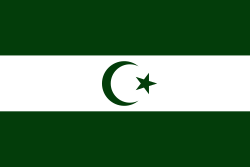 | |
| Use | Civil and state flag |
|---|---|
| Proportion | 2:3 [1] |
| Adopted | 26 February 1994 (original), 19 November 2003 (modified) |
| Design | A horizontal tricolor of green, blue, and red. |
| Designed by | Abdulvagab C. Muratchayev (ГӀабдулвагьаб Муратчаев) |
The flag of Dagestan [a] was adopted after the transformation of the Dagestan ASSR into the Republic of Dagestan within the Russian Federation. The flag was formally adopted on 26 February 1994. [2] It features a horizontal tricolor of green (for Islam), [3] blue (for the Caspian Sea), [3] and red (for courage and fidelity). [3] On 19 November 2003 the proportion of the flag was changed from the original 1:2 to 2:3, and the middle stripe from light blue to blue. [1]


















